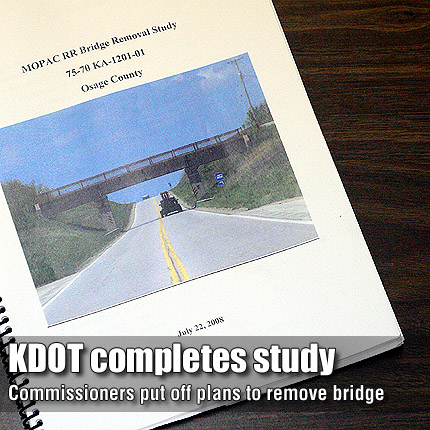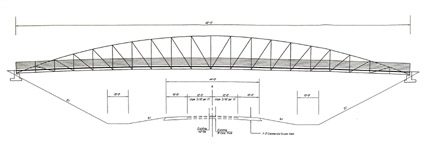|
|
 |

Commissioners: We’ll fund that
bridge when we get there
Tuesday, Oct. 7
Wayne White
Managing Editor
It will likely be years before an old railroad bridge over U.S.
Highway 75 north of Lyndon is removed, state highway officials revealed
last week.
A study conducted by the Kansas Department of Transportation (KDOT)
has concluded the best solution to satisfy county commissioners
and rails-to-trails proponents is to spend approximately $1.5 million
to remove the bridge, columns and abutments, relocate a nearby residence,
and construct an arch pedestrian bridge 187 feet long.
The main obstacle is the state of Kansas has no funds for such a
project, said Clay Adams, KDOT district engineer.
The study began in February when county officials asked if the bridge
could be removed, citing dangerous conditions due to the narrow
road at the bridge, inability of oversize loads to pass under the
bridge, and traffic blockage due to oversize loads traveling on
U.S. 75.
KDOT officials met with the Osage County Commission Oct. 1 to present
the results of the study.
The bridge is part of the rail-banked Missouri Pacific line, portions
of which are being developed by the Kanza Rails to Trails Conservancy
(KRTC) as hiking, biking and horseback trails.
James Dietzel, squad leader for the study, explained the seven options
considered, which ranged from doing nothing to building the pedestrian
bridge.
The first option, doing nothing, “is not preferred by the
county because the situation of the bottleneck will not be resolved
in the near future,” Dietzel said.
That option would serve the trail conservancy, according to Frank
Meyer, a spokesman for the Kanza Rail to Trails Conservancy.
“The bridge as is serves our purposes without any problem,”
Meyer told the commission. “It’s a problem with the
traffic on 75 and has been for a number of years. But as far as
we’re concerned, the bridge is fine.”
A second option would be to remove the bridge with no additional
work on the highway, although it was not a preferred option “because
KRTC would lose continuity through its junction with U.S. 75,”
Dietzel said. He said it would cost an estimated $60,000 to remove
the bridge.
Option 3 would remove the bridge and build an at-grade crossing;
it was deemed not feasible because it would be unsafe for pedestrians
to cross the high volume two-lane highway.
Two other options considered reinforced concrete boxes to build
a tunnel under the road. At the bridge location, a tunnel was determined
as not be feasible because of drainage issues, which could cause
the trail to be impassable during storms. The other tunnel option
would place the tunnel approximately 1,600 feet north of the existing
bridge, detouring the trail along the highway to the crossing. Because
of the detour, “some trail users may decide to cross U.S.
75 at the trail, which is unsafe,” Dietzel said.
The detour with a tunnel was estimated to cost $503,000.
Two pedestrian bridge options were considered. One would remove
the railroad bridge and replace it with a 100-foot pedestrian bridge
at an estimated cost of $489,000.
“This option does not address any drainage or roadway width
concerns,” Dietzel said.
The other pedestrian bridge option proposes removing the old bridge,
and replacing it with a 187-foot span. It would increase the vertical
clearance and allow for less restricted horizontal clearance. Ten-foot
shoulders and 10-foot ditches would be built.

Option 6 of a Kansas Department of Transportation study of the
railroad bridge on U.S. Highway 75, calls for the removal of the
old bridge and construction of a 187-foot pedestrian bridge.
One problem associated with the proposal would be the need to acquire
additional right-of-way. Total cost was estimated at $1,569,000.
“This option would require an additional $225,000 to relocate
the property owner,” Dietzel said.
He said the study concluded that the smaller pedestrian bridge was
“the most feasible economically.”
Dietzel said the state spent about $60,000 to conduct the study.
During the discussion, Osage County resident Jim Foster said the
bridge should be removed at the owners’ expense.
“This is private property, that is privately managed, and
it is the railroad’s bridge … and there are people that
are supposed to be in charge and taking care of it and maintaining
it,” Foster said. “So why are you not going to the trail
operators to recoup the money to remove the bridge and do what’s
needed?”
Not waiting for an answer, Foster also complained that the existing
bridge has “chunks of concrete falling out of it now.”
“They’ve not seen that it is inspected, they’ve
not done the responsible thing in maintaining it,” Foster
said.
Dietzel replied that the study found no instances of property damage
or accidents resulting from falling concrete.
Foster argued that chunks of concrete are missing from the north
side of the bridge.
“That happens to be a roadside bomb that’s going to
go off,” he said. “Without the inspections on it, we
don’t know when the next chunk’s going to fall off.
That bridge needs to be removed and removed now.”
Adams said he believed the missing chunks of concrete resulted from
an oversize load hitting the bridge.
Adams also answered a question of whether inspections are required
on unused railroad bridges.
“At the current time the state is not responsible for inspecting
railroad bridges or former railroad bridges over any state highway,”
Adams said. “The railroad or owner of the bridge are required
to inspect the bridges, but there is not a penalty from the federal
government or anyone at this time, if they don’t. On a current
railroad bridge over a highway, the railroad inspects it, but they’re
not required to give that information to state or federal government.
They just have to say it’s been inspected. If it’s railroad
bridge owned by private entity, it doesn’t fall under the
inspection requirements.”
Foster pointed out an error in the state’s study, saying the
rail line was not abandoned as stated in the report, but instead
it is rail-banked.
Adams agreed, saying he would send a correction to be included in
the report.
In his presentation of the study, Dietzel noted no recent traffic
accidents in a half-mile area near the bridge have been attributed
to the restriction in the road. A report included in the study notes
18 accidents in the area have occurred from 2002 to 2006; five involved
injuries; 10 occurred at the intersection of U.S. 75 and state Highway
31; five were caused by animals in the road. There were no fatal
accidents in that stretch of highway during the five years studied.
Although KDOT conducted the study, Adams said there currently are
no funds available for such a project. He said the current highway
program is set to expire next year, and all projects under that
program are underway or completed.
“Other projects will have to wait until the next highway program,”
Adams said.
“It’s not on a priority list right now,” said
KDOT engineer James Brewer.
Adams offered several recommendations for funding, including funding
by local government entities such as Osage County, Osage City and
Lyndon.
“If the locals were able to come up with funding, our deputy
has offered KDOT to do the design work … and possibly the
inspections,” Adams said. “He’s offered to come
up with $100,000 if locals come up with funding.”
Other options would be to take advantage of the state’s revolving
loan program or transportation enhancement funds if they are included
in the next highway program.
“The next step at this point is for the county to take this
under consideration,” Adams said.
Adams said KDOT would provide the study and collected information
to the county for future consideration.
Meyer said KRTC would be satisfied with whichever plan the county
chose, as long as a bridge spanned the highway.
“We will work with you to help you solve your problem of getting
the traffic through it.” Meyer said. “We have no problem
with what you’re doing.” |
|
 |
|